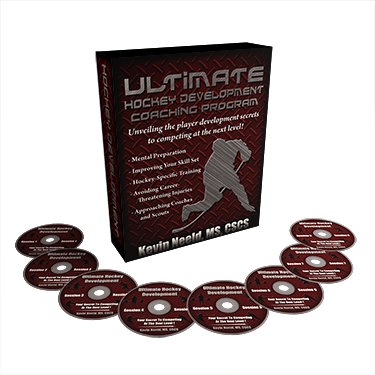Kevin gathered the world’s top experts in performance training, injury prevention and rehabilitation, sports nutrition, on-ice skill development, and career advancement for the most in-depth hockey development interrogation ever conducted. In these 12 Coaching Calls, you’ll here these experts tell you exactly what strategies they use to build strong, fast, injury-resistant, skilled, mentally tough hockey players. Because all the calls are downloadable MP3s, you can listen to the calls on your iPod, MP3 player, or phone at your own convenience!
Ultimate Hockey Development Coaching Program
The Difference Between a 1-Leg Squat and 1-Leg Deadlift
After talking to Nick Tumminello, I changed the way I do 1-leg squats. I used to do them with the “up leg” out in front. Some people call this a pistol squat (I hate that name). Now I do them with the up leg behind the body.
I made the switch from the “up leg in front” to “up leg in back” in the middle of this summer. In my afternoon hockey training group at Endeavor, I wrote a 1-leg squat and 1-leg deadlift into the same training session.
Switching to the “up leg in back” version of the 1-leg squat prompted a lot of my athletes to ask what the difference was between them. This really got me thinking. Watch these videos and see if you can pick up on the differences between these two. It’s pretty subtle.
1-Leg Squat
[quicktime]http://www.kevinneeld.com/videos/1-Leg%20DB%20Squat%20Pattern.mov[/quicktime]
1-Leg Deadlift
[quicktime]http://www.kevinneeld.com/videos/1-Leg%20DB%20Deadlift%20Pattern.mov[/quicktime]
-Kevin Neeld
A Valuable Coaching Lesson
This Summer I’ve been fortunate to work with a group of highly motivated hockey players pursuing various levels of professional hockey.
Last week one of my guys said something that stuck with me. Something that I wrote about in my Off-Ice Performance Training Course.
He said something that went like:
“I hate Wednesdays. This day is BRUTAL. I can’t even complain to you though because I know you’re doing it all too.”
So what’s the big message here?
I put that group through tough training sessions. Need a partner to push you through it, tough. Need to take a look inside yourself and see if you’re mentally strong enough, tough. Tough.
And I know how tough they are because I do every single training session, exactly as written. My athletes know that. They respect that.
Coaches that preach, but don’t do (or haven’t done, in the case of some of the older coaches) rarely have the respect of their players.
Think about it-Would you want to be bossed around by some lazy loud mouth with a whistle?
I’m not saying every coach needs to follow the same training program as their athletes, but every coach should be setting a good example.
Athletic development coaches should stay fit.
Youth sport coaches should maintain and seek to improve their skill levels in that sport.
And last, but not least, nutritionists should not be fat (I’ll save that rant for another day).
Train your athletes hard. Train yourself harder.
-Kevin Neeld
Is Time Magazine Trying to Kill You?
Last week, one of the athletes I train approached me about an article he came across in Time Magazine.
My reaction to his comments was: “You have to be kidding me.”
I was going to blast the article and the complete lack of social responsibility Time Magazine showed by printing the article.
This is just ANOTHER example of a staff writer for a magazine completely misinterpreting research and putting together a story of lies with a catchy title to attract an audience.
Effective journalism, yes. Effective lifestyle advice, no. In fact, printing articles like this is dangerous and essentially says that Time Magazine weighs you reading their article more than your life (or at least your quality of life).
I don’t want to waste too much time on this crap.
John Berardi took a more level-headed approach to commenting on this article.
Find out what his response was to the “Exercise makes you fatter” slogan of Times Magazine.
-Kevin Neeld
Everything You Need to Know About Testes
This isn’t going to be nearly as crude as you’re hoping for.
…but it got you this far didn’t it?
Performance nutrition expert Dr. John Berardi, along with the help of Dr. Bryan Walsh, put out these two posts that do an awesome job explaining the cause and results of hormone imbalances in both men and women.
As a man, I found this first post (and the two videos with it) to be very enlightening. If you’re a fan of testosterone boosting supplements, this is a must watch for you.
Men: http://www.precisionnutrition.com/testosterone-replacement
As a man, I found this second post (and the two videos with it) to be very…I got nothin. I made it about 3 minutes into the first video and realized that the only things I’ll ever know about women is that they are all different, but equally confusing.
I still recommend you check out the link though. Maybe you’ll have better luck than I did.
Women: http://www.precisionnutrition.com/female-hormones
– Kevin Neeld




 Use CODE: "Neeld15" to save 15%
Use CODE: "Neeld15" to save 15%